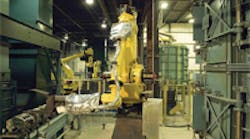High-volume thermal processing of aluminum-intensive components has concerned manufacturers since the mid 1960s, when such products were introduced for automotive use. Cycle time requirements resulted in the design and manufacture of large batch or long, linear continuously fed, conveyorized heat-treatment systems.
Today, faced with higher quality and cost pressures, manufacturers are looking for efficient, high-volume heat-treating methods for aluminum components. Processors of aluminum castings and formed components can benefit from a modernized heat treatment system — one that incorporates lean manufacturing advantages, and is fully integrated into the manufacturer’s process.
Automotive engineers favor aluminum because of its unique combination of strength, light weight, crash energy absorption, and corrosion resistance. These properties and others typically are enhanced by heat treatment.
The use of aluminum automobile components has grown steadily from an average of 54 lb (25 kg) per car in 1960 to 273 lb (124 kg) in 2002, mainly to reduce weight and improve fuel economy. The Drucker Worldwide report, “Global Automotive Content Forecast Through 2010,” projects that there will be 318 lb (144 kg) of aluminum used in North American light vehicles by 2010.
Typically, aluminum castings and formed products are thermally treated to achieve a desired set of mechanical properties, proper metallurgical structure, and acceptable residual stress levels. Heat-treating processes typically require multiple heating and holding steps with intermediate cooling or quenching operations. Soak times can vary from less than a minute for thin sheet to as long as 20 hours for large sand castings.
As a result of the heat-treating requirements, furnace engineers developed large batch and continuous furnaces that employ long continuous roller-hearth conveying systems to satisfy the demand for high-volume aluminum product production. Presently, it is not uncommon for roller-hearth systems to span over 200 ft. Other major areas of concern for manufacturers are costs and problems associated with maintaining and replacing consumable product conveying baskets, and energy consumed through the heating of baskets, which has no redeeming value.
Realizing that opportunities exist to improve commonly used roller-hearth conveying systems, engineers at Can-Eng and their partners NFK began evaluating available equipment options. The goal was to develop a system that satisfies increasing product demand while improving productivity and quality. Target areas of design improvement included: reducing energy consumption, reducing floorspace requirements, improving thermal profiles, improving mechanical properties, ease of operation, maintainability, and singular part flow.
Analysis of existing technology benefits and drawbacks together with consideration given to several system configurations identified the rotary-hearth furnace as an existing system configuration that, if modified, could achieve all the targeted areas of improvement. The basic system design is cylindrical; products are loaded and unloaded through common openings. The products are positioned on an internal carousel that rotates through a heating and soaking cycle. The carousel is driven from below via a single drive unit.
The carousel is designed and manufactured to support product families of similar geometry. The products unique features are carefully considered during the design of the furnace system to ensure products are properly supported to prevent damage or distortion. Opportunities to process different product families can be accomplished easily through the integration of a modified internal carousel.
System sizing is determined through detailed calculation incorporating the products’ required thermal profile and the physical geometry.
Given the singular part flow the Basketless Heat Treating System (BHTS), quenching is simplified. The quenching system, whether it be a hot water, polymer, or controlled-air media is smaller and can be mounted at floor level. As a result, BHTS quench systems do not require foundation pits and ancillary facility requirements. They are sized smaller and are no longer burdened by the additional cooling requirements of a basket.
The BHTS is an efficient system that is commercially available to manufacturers of aluminum castings and formed products. Multiple users of these have exploited the numerous benefits over conventional roller-hearth and other types of heat-treatment systems. Energy consumption is greatly reduced as a result of eliminating baskets and reduced electrical usage.
The system is cylindrical and compact, taking advantage height and thereby reducing floor space expansion costs. Operator and maintenance involvement is reduced as a result of fewer burners, fans, and drives to be monitored. Equipment spare inventory is reduced as a result of fewer components integrated into the system. Product quality is improved through single part processing, reducing the temperature profile spread over densely loaded basket systems and quench optimization. Lastly, work in process (WIP) inventories can be reduced, enhancing lean manufacturing processing.













